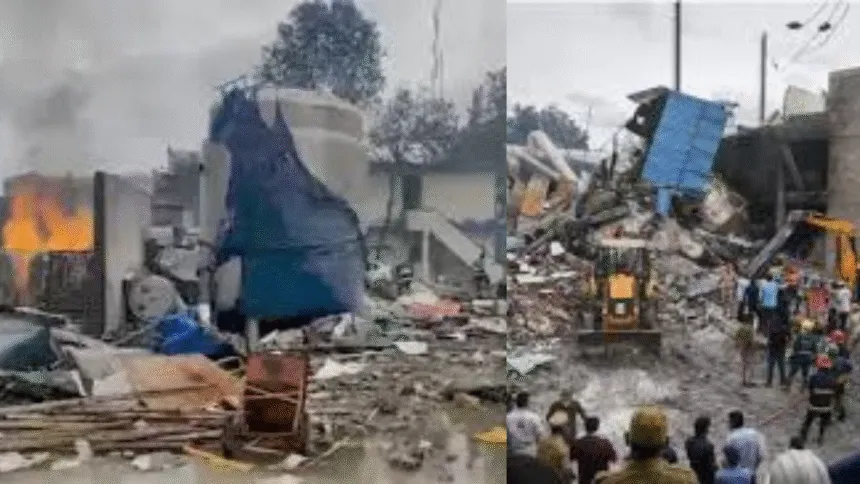In a statement signed by Ms Jhansi and Mr. Srikant Mohanty respectively as co-convener and member of AIKMKS and AIFT U (New) the Pashamilaram Sigachi Accident that happened on June 30, 2025 and shocked the working class and all people with a conscience in India, has been deplored and a proper investigation demanded.
A devastating reactor explosion occurred at Sigachi Industries Ltd. in Pashamilaram, Sangareddy district, Telangana on June 30. The blast resulted in the tragic deaths of workers, employees, and managers present at the facility at the time. Initial reports on July 1 stated that 19 people died instantly, with 40 others suffering injuries. However, the death toll and number of injured is rising day by day. There is significant confusion surrounding the exact number of workers at the site during the accident. The company claims there were 60 workers present, while the government says it is 143. So far, 43 deaths have been officially confirmed, though this number is likely to increase.
Due to the absence of basic medical facilities and ambulances at the plant, the injured were transported to nearby hospitals in buses, further exacerbating the severity of the situation. Many of the bodies were so badly charred that DNA testing is being conducted to identify the victims. Scenes of grief and desperation have unfolded as family members, holding Aadhaar cards and photographs of missing workers search for their loved ones. Dozens of workers remain unaccounted for. All the victims, both dead and injured, were migrant workers from various states, including Telangana, Bihar, Orissa, Bengal, Andhra Pradesh, and Karnataka. While the company has been accused of downplaying the number of workers inside the facility at the time of the explosion, the discovery of extra cell phones in the cloakroom suggests a much higher number of workers present than initially reported. While industrial accidents in Telangana have tragically claimed lives in the past, this particular disaster stands out as one of the most catastrophic in the state’s history.
For a long time, both central and state governments have embraced the ideology that the more the number of Billionaires the greater will be the country’s development. The Bharatiya Janata Party, in particular, has championed the belief that “investors are the wealth creators”. Influential business tycoons like Ambani and Adani have been pouring significant sums of money into political parties that espouse these policies, helping to bring them to power.
As a result, many of the laws and regulations introduced by the government tend to heavily favor capitalists, allowing them to reap unlimited profits. A prime example of this can be seen in the Government Order (GO) introduced by the Telangana government under the BRS (Bharat Rashtra Samithi) in 2017. This particular GO has come under scrutiny following the recent explosion at Sigachi Industries in Pashamilaram, which highlights the dangerous consequences of prioritizing capitalist’s interests over workers’ safety and regulatory oversight.
It has been a long time since the central and state governments have accepted the slogan that if the country is to develop, all facilities should be provided to the investors. In this, the Bharatiya Janata Party has decided that ‘wealth creators are investors’. Big investors like Ambani and Adani are investing crores of rupees in political parties with such ideology and policies and bringing them to power. As a result, the laws brought by the government are completely in favor of the investors and they are able to make unlimited profits. For example, we can see that the GO brought by the then BRS government in power in Telangana in 2017 is now related to the explosion in the Sigachi industry in Pasmailaram.
Through G.O. No. 9/2017, the Telangana government introduced several measures that greatly favor industrial owners, allowing them to operate companies with minimal regulatory oversight. The Factory Department, in particular, granted multiple exemptions from routine inspections. Under this policy, industries were classified according to the number of workers, with specific inspection schedules based on their risk levels:
Low Risk: Industries with fewer than 30 workers were categorized as “low risk” and only required inspection every 5 years.
Medium Risk: Companies with 31 to 100 workers were classified as “medium risk” and subject to inspection every 3 years.
High Risk: Industries with more than 101 workers were considered “high risk” and were inspected every 2 years.
New companies were exempt from inspections altogether, and the introduction of online inspections and self-certification allowed companies to bypass traditional scrutiny. In the past, departments such as the Factory, Labor, and Environment Departments conducted surprise inspections every 3 months to ensure compliance with safety and welfare standards. They checked machinery performance, air and light conditions, and overall workplace safety, ensuring that industries obtained clearance certificates before continuing operations. However, these routine checks have now been significantly reduced or eliminated in the name of “Ease of Doing Business.” This regulatory relaxation has opened the door for capitalists to hire unorganized labor at minimal wages, often subjecting them to unsafe working conditions for the sake of maximizing profits.
At the same time, imperialist nations are offloading hazardous, chemical, and toxic industries to developing countries like India to safeguard their own territories. This strategy ensures their profits while leaving countries like India to shoulder the risks associated with such industries. Reports suggest that the reactor responsible for the Sigachi Industries explosion was outdated, and the workers operating it lacked the necessary professional skills to manage such high-risk equipment. This negligence, driven by cost-cutting and profit-driven motives, underscores the human cost of these lax regulatory frameworks.
Why do workers have to risk their lives working day and night for industrial production? While the workers at Sigachi Industries are losing their lives and their families are suffering, the management’s primary concern is the drop in their company’s stock market value. This shocking disparity highlights the priorities of those in power: profit over people. As if the existing exploitation and insecurity of labor were not enough, the central government has pushed four new labor codes to further benefit corporate management. These codes will strip workers of the limited protections they had under existing labor laws, leaving them even more vulnerable to the greed of business owners and the brutal exploitation of their labor. It’s crucial to recognize that both the central and state governments, along with the ruling political parties, are working entirely in the interests of the capitalists. They have created a system where industry profits come before the well-being of workers, and anyone who questions these anti-labor, anti-people policies is quickly labeled as “anti-development” and subjected to harsh repression.
The development model being implemented by the governments is not for the people—it is designed to serve the interests of capitalists, feudal forces, and imperialist powers. Every industrial accident, like the one at Sigachi Industries, is a result of criminal negligence. These accidents happen because the wealthy, with their vast resources, refuse to invest in the necessary safety measures or repairs. Instead, they rely on the assumption that insurance will cover the costs of workers’ lives—an arrogance that treats human lives as expendable.
We should recognize that opposing such an anti-people development model is a truly patriotic act. It is essential for us to mobilize and demand a system that values human life over profit that prioritizes workers’ rights over corporate greed.
(The contact number of the signatories is 6370592002)
Comments
0 comments







